Ennion: Ancient Master Of Glassblowing And His Legacy
A. Sutherland - AncientPages.com - Among the earliest workshops that designed and created mold-blown glass was the one that belonged to Ennion, but even before him, there were other glassblowers.
 Glass hexagonal amphoriskos dated to 1st half of 1st century AD. Signed by Ennion. source
Glass hexagonal amphoriskos dated to 1st half of 1st century AD. Signed by Ennion. source
The earliest evidence of glassblowing comes from a collection of waste from a glass shop, including fragments of glass rods, glass tubes, and tiny blown bottles. The remains of this collection were dumped in a mikvah, a ritual bath in the Jewish Quarter of the Old City of Jerusalem.
Ennion was an ancient glassblower, a well-known glass craftsman, and a true master who lived and worked in the first half of the early century AD. He was known for his high-quality antique glass artworks. His creations had beautiful shapes.
Ennion created elegant molded glass vases reproducing the embossed decorations of the precious Alexandrian containers of chiseled or engraved metal. He decorated his small, elegantly shaped flasks, jars, cups, bowls, pitchers, and beakers with remarkably modern-looking floral and geometric designs.
Their colors ranged from rich cobalt blue amber, brown, goldish-brown, and green to pale aqua or ash-like white.
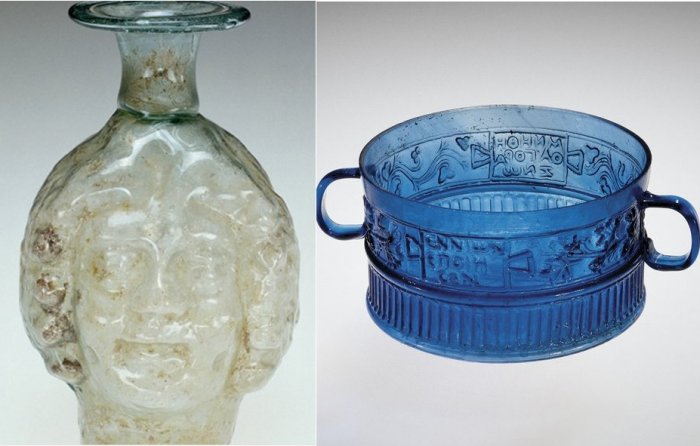 Left: Double Head Flask, Roman Empire; probably Eastern Mediterranean, 200-225. 50.1.15. The Corning Museum of Glass, Corning, New York. Right: Cup, Ennion, Syria; Palestine; Northern Italy, 25-75. 66.1.36. The Corning Museum of Glass, Corning, New York. source
Left: Double Head Flask, Roman Empire; probably Eastern Mediterranean, 200-225. 50.1.15. The Corning Museum of Glass, Corning, New York. Right: Cup, Ennion, Syria; Palestine; Northern Italy, 25-75. 66.1.36. The Corning Museum of Glass, Corning, New York. source
Ennion was a true artist whose signature is known from over thirty surviving pieces, all of which are masterpieces. Ennion was the first known glassmaker to sign his glass objects by adding inscriptions ("Ennion made it") that formed part of the mold's design.
The priceless examples of Ennion's work are in the collection of The Metropolitan Museum of Art; the others, however, are elsewhere in different locations.
Behind Ennion's Glass Masterworks Are Hidden Stories Of Their Owners
To shape the ancient glass, Ennion used a detailed design. The mold-blown glass vessels of ancient Rome tell a wealth of stories about the ancient world, from gladiators to perfume vessels, from portraits of a Roman empress to oil containers marked with Mercury's image, the Roman god of trade. We know Ennion's name because archaeological excavations unearthed and recovered some of his glass artworks in different locations around the Mediterranean Sea.
Possibly the first glass craftsman to sign his name to his work, he expanded the craft and production of glassblowing through a new technique, using molds. Perhaps he even invented the process, which is still in use today.
Who Was Ennion And Where Did He Live?
Very little is known about this man, and information about him is obscure; even his name is not believed to be Greek or Roman. Ennion was perhaps a Phoenician or a Jew who lived and worked in the coastal region of Phoenicia in the early part of the first century AD. At first, the artisan was linked with Alexandria, Egypt, and later, with the city of Sidon.
 Roman; Ennion jug; Glass by Ennion. source
Roman; Ennion jug; Glass by Ennion. source
Based on Pliny, Strabo, Flavius Josephus, and Tacitus, Ennion worked in Sidon or its vicinity. This ancient city was a leading center of glass production and was famous for glass art in Roman times.
Master Ennion did not indicate his workshop's geographical location or the period he worked. His exquisite artistry pottery was found in Italy's various locations, especially in Adria, Cyprus, Crimea, Greece, Spain, Morocco, France, and southern Germany.
Besides, Sidon (now the third-largest city in Lebanon) was a city with many, even distant, trade connections. Many wanted to trade ceramics from Asia Minor, including those created by Ennion.
Many experts believe Ennion worked in or in Sidon's vicinity, a city located on the eastern coast of the Mediterranean Sea in northern Palestine. His glass vessels signed by him were unearthed in Jerusalem and Syria. Near Jerusalem, ancient glassworkers could inflate hot glass to quickly and cheaply make ceramics.
Sidon has long been credited as the birthplace of the mold-blowing technique. Others have suggested that Ennion's workshop was located in Italy because most drinking cups decorated with his name were found in Italian locations.
Many glass vessels come from various archaeological excavations in the region of the Mediterranean. Another possibility is that the great glassblower started his career in the East and later moved his workshop to Italy's new location. Many show similarities to the Ennion-style but lack the master glassblower's signature – Ennion.
Therefore, we can conclude other artisans imitated his original and highly sophisticated artistry daily.
Written by – A. Sutherland - AncientPages.com Senior Staff Writer
Updated on September 20, 2022
Copyright © AncientPages.com All rights reserved. This material may not be published, broadcast, rewritten or redistributed in whole or part without the express written permission of AncientPages.com
Expand for referencesReferences:
E. M. Stern, Roman Mold-blown Glass
"Review: 'Ennion,' at the Met, Profiles an Ancient Glassmaker" R. A. Grossmann, Ancient Glass
More From Ancient Pages
-
 Tragic Tale Of The Cursed House Of Atreus
Featured Stories | Apr 12, 2021
Tragic Tale Of The Cursed House Of Atreus
Featured Stories | Apr 12, 2021 -
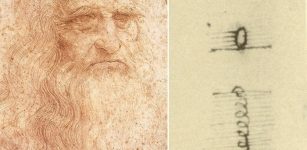 Leonardo da Vinci’s Paradox Cracked
Ancient Technology | Jan 19, 2023
Leonardo da Vinci’s Paradox Cracked
Ancient Technology | Jan 19, 2023 -
 Unique Find In A French Crypt Offers The First Evidence Of European Familial Embalming Dating Back To The 16th Century
Archaeology | Nov 20, 2024
Unique Find In A French Crypt Offers The First Evidence Of European Familial Embalming Dating Back To The 16th Century
Archaeology | Nov 20, 2024 -
 On This Day In History: The Gregorian Calendar Implemented – On Oct 5, 1582
News | Oct 5, 2016
On This Day In History: The Gregorian Calendar Implemented – On Oct 5, 1582
News | Oct 5, 2016 -
 Mysterious Shemsu Hor – Followers Of Horus Were Semi-Divine Kings And Keepers Of Sacred Knowledge In Predynastic Egypt
Ancient Mysteries | May 15, 2017
Mysterious Shemsu Hor – Followers Of Horus Were Semi-Divine Kings And Keepers Of Sacred Knowledge In Predynastic Egypt
Ancient Mysteries | May 15, 2017 -
 Mysterious Pre-Celtic Civilization Who Came To Ireland From An Unknown Land
Featured Stories | Aug 13, 2024
Mysterious Pre-Celtic Civilization Who Came To Ireland From An Unknown Land
Featured Stories | Aug 13, 2024 -
 Ambition, Greed And Death: The Roman Roots Of ‘Game Of Thrones’
Featured Stories | Jul 2, 2019
Ambition, Greed And Death: The Roman Roots Of ‘Game Of Thrones’
Featured Stories | Jul 2, 2019 -
 Ancient Egyptians Had A Different Definition Of ‘Foreigners’
Ancient History Facts | Apr 14, 2018
Ancient Egyptians Had A Different Definition Of ‘Foreigners’
Ancient History Facts | Apr 14, 2018 -
 On This Day In History: Battle Of Rudau Was Fought – On Feb 17, 1370
News | Feb 17, 2017
On This Day In History: Battle Of Rudau Was Fought – On Feb 17, 1370
News | Feb 17, 2017 -
 Geomagnetic Fields Reveal The Truth Behind Biblical Narratives
Archaeology | Oct 25, 2022
Geomagnetic Fields Reveal The Truth Behind Biblical Narratives
Archaeology | Oct 25, 2022 -
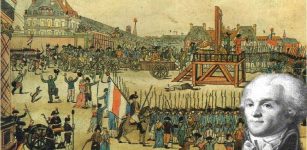 On This Day In History: Maximilien Robespierre Sent To The Guillotine – On July 28, 1794
News | Jul 28, 2016
On This Day In History: Maximilien Robespierre Sent To The Guillotine – On July 28, 1794
News | Jul 28, 2016 -
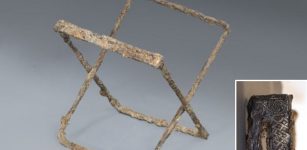 Extremely Rare Medieval Folding Chair Reveals Its Secrets
Archaeology | Oct 13, 2023
Extremely Rare Medieval Folding Chair Reveals Its Secrets
Archaeology | Oct 13, 2023 -
 Top 10 Archaeological Discoveries 2023
Archaeology | Dec 27, 2023
Top 10 Archaeological Discoveries 2023
Archaeology | Dec 27, 2023 -
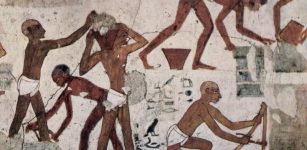 World’s First Documented Labor Strike Took Place In Ancient Egypt In The 12th Century BC
Ancient History Facts | Jun 7, 2016
World’s First Documented Labor Strike Took Place In Ancient Egypt In The 12th Century BC
Ancient History Facts | Jun 7, 2016 -
 Men And Women Had Equal Access To Resources 6,000 Years Ago
Archaeology | Jun 17, 2024
Men And Women Had Equal Access To Resources 6,000 Years Ago
Archaeology | Jun 17, 2024 -
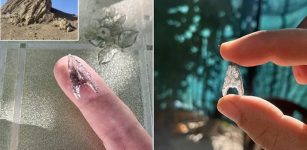 Obsidian Flake From 45,000-Year-Old Tool Unearthed In Armenia
Archaeology | Jul 18, 2022
Obsidian Flake From 45,000-Year-Old Tool Unearthed In Armenia
Archaeology | Jul 18, 2022 -
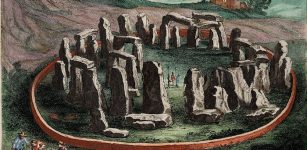 Hunter-Gatherers Used Open Habitats Millennia Before Stonehenge Monuments Were Built
Archaeology | Apr 27, 2022
Hunter-Gatherers Used Open Habitats Millennia Before Stonehenge Monuments Were Built
Archaeology | Apr 27, 2022 -
 Time Capsule – Best Preserved 3,000-Year-Old Dwelling Ever Found In Britain
Archaeology | Jan 12, 2016
Time Capsule – Best Preserved 3,000-Year-Old Dwelling Ever Found In Britain
Archaeology | Jan 12, 2016 -
 Invention Of Ancient Military Technologies Throughout World History Investigated
Archaeology | Oct 23, 2021
Invention Of Ancient Military Technologies Throughout World History Investigated
Archaeology | Oct 23, 2021 -
 Hidden Details In Ancient Egyptian Tomb Paintings Revealed By Chemical Imaging
Featured Stories | Jul 28, 2023
Hidden Details In Ancient Egyptian Tomb Paintings Revealed By Chemical Imaging
Featured Stories | Jul 28, 2023
